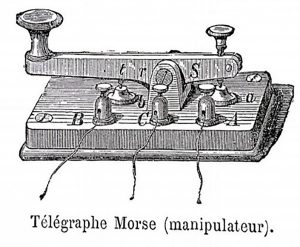Morse Code: What Hath God Wrought?
by admin | March 6, 2020 7:32 am
I recently watched The Spy, a Netflix show set in Syria and Israel during the Six-Day War in 1967. Actor Sacha Baron Cohen is embedded in Syria. Inside his apartment, he hunches over the telegraph key, tapping out messages in Morse Code that are eagerly received and transcribed at the other end. The transcribed message is quickly transported to his handlers in Israel. I’m a little hazy on the details of the series beyond that. Television shows tend to run together in my memory. So do novels.
My faulty fiction memory baffles my Beautiful Mystery Companion since my recollection of historical facts remains fairly strong. I figure the hard drive of my brain is fast reaching capacity, so something has to be offloaded. It might as well be the plots of easily forgettable television series or mystery novels.
Samuel Morse didn’t exactly invent the telegraph, but he improved it to the extent its signal could travel down the wire for many miles. In 1844 his most famous demonstration to dubious members of Congress, who had agreed to fund his project, sent a message the 40 or so miles from the Supreme Court’s chamber in Washington, D.C. to Baltimore. The message: What Hath God Wrought?  [1]The telegraph and railroad construction went hand-in-hand, with poles planted alongside railroad tracks, linking the coasts of this country and spurring settlers to head west, for Native Americans to be further murdered and marginalized, for towns to spring up across this country all the way to the Pacific Ocean. Indeed, what hath God wrought?
[1]The telegraph and railroad construction went hand-in-hand, with poles planted alongside railroad tracks, linking the coasts of this country and spurring settlers to head west, for Native Americans to be further murdered and marginalized, for towns to spring up across this country all the way to the Pacific Ocean. Indeed, what hath God wrought?
I have been reading a book by Steve Innskeep, one of the morning hosts of Morning Edition on National Public Radio: Imperfect Union: How Jessie and John Fremont Mapped the West, Invented Celebrity, and Helped Cause the Civil War. Innskeep takes sabbaticals every several years to write books – a talented fellow. In Imperfect Union, he describes the scene in the Supreme Court chamber, which at the time was located below the Senate chamber: Men had run copper wires into the room and attached them to a Grove battery, made with nitric acid in a ceramic container. The wires also connected to a device made of wood and metal, small enough to rest on one of the tables. A man sometimes pressed a lever on the device, which produced a clicking sound. Other times the device appeared to click on its own, and the man paid strict attention, as if the clicks were some kind of language.
Morse Code is not a language. As the name indicates, consider it a form of coding, a 19th-century precursor to the “ones” and “zeros” of modern computer coding. It turns the individual letters of many different languages, not just English, into bits and bytes, as one online explanation says. I learned Morse Code as a kid. A childhood friend, Garry Osgood, and I were fascinated by shortwave radio and learning Morse Code, then still used widely by ham operators. With radio transmission replacing the telegraph, knowing Morse Code eventually fell into the category of a charming hobby. It was still a requirement to be an amateur radio operator for some classes up until 2007, when it was eliminated entirely. Even then, one was only required to be able to translate at 5 words-per-minute. I doubt I got that fast as a kid, even at my peak.
Garry Osgood was further along on the tech-nerd highway. He had already built a shortwave radio and had a tower antenna outside. I spent a lot of time at his ramshackle house near the Suncook River in Allenstown, N.H. We spent hours trying to transcribe the signals sent in Morse Code. I was never very good at it, only able to catch the occasional word. It was far more useful for me to tune in to the BBC, Voice of America or other stations where folks were speaking, even if it was in a foreign language.
There are plenty of YouTube videos demonstrating how to use Morse Code. It is used sparsely in aviation and aeronautical fields. One of the most interesting uses is for people with disabilities, which preclude them being able to speak or write, learning to communicate via Morse Code by blinking their eyelids.
Things ended badly for Sacha Baron Cohen in The Spy. I don’t want to spoil this for anyone who might want to watch the show, so I’ll just leave it at that.
- [Image]: http://garyborders.com/pages/morse-code-what-hath-god-wrought/telegraph-transmitter/
Source URL: https://garyborders.com/pages/morse-code-what-hath-god-wrought/